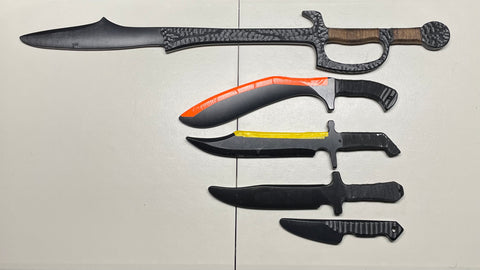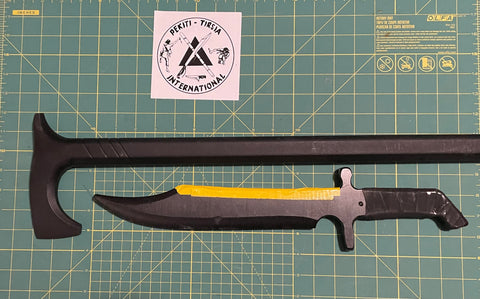FMA TRAINING TOOLS

FMA TRAINING TOOLS
A discussion of the pros and cons of various materials for training in Filipino Martial Arts, by Tuhon Bill McGrath
RATTAN

The first material that comes to mind for training in Filipino Martial Arts is, of course, sticks made from rattan. The pros of rattan for training are many, but we will focus on two here; one being that it is relatively light in weight (when compared to hardwoods) and the other is its flexibility. These two factors make it a good wood for FMA students to begin their training with, as the light weight means that it is less likely to break a training partner’s bones during an accidental hit. Rattan’s flexibility also helps the joints of the user, as this lessens the shock and vibration that gets transferred to the user’s joints on impact. This lessening of shock to the joints helps prevent tendonitis in the joint and is said to also help prevent arthritis in the joints, compared with doing the same training with an inflexible hardwood. When we began our training with Tuhon Gaje in the 1970s, we used to call drills with rattan sticks “Filipino Iron Palm Training” because of the effects it had on our hands. A more detailed description of this can be found in this video.
For more on Rattan as a training wood in FMA, read my essay "Why Rattan?"
https://pekiti.com/blogs/news/why-rattan
HARDWOODS: 
TOP: A Hickory trainer I made by cutting an axe handle down to match the size of my short sword.
BOTTOM: A much nicer version done by Magino'o Dan Terrell.
While we used lightweight rattan for drills and sparring, Tuhon Gaje had us use hardwoods for hitting the tires for power development. The wood used for this was commonly Bahi, which came from heart of the Anáhaw palm. (1) Tuhon Gaje also chose Bahi wood for his personal fighting sticks as a leader of dock workers in the 1960s (where the “negotiations” for the contracts to unload the ships resembled gang wars. But that is a story for another day). Another hardwood commonly used for fighting in the Philippines was Kamagong (2). This was not as favored though by Tuhon Gaje, as it was more brittle than Bahi and was prone to break suddenly, leaving you with a shortened weapon in the middle of a fight.
For the last few years, we have been working with hickory, which is one of the highest rated hardwoods for impact resistance and is therefore used on tool handles that need to be tough, such as axe, pick and sledge hammer handles. Several years ago, Guro Dan Terrell made some wooden sword trainers from hickory axe handles (3) for his fellow PTI instructors and they have become our favorite wooden sword trainers for any task that requires surviving repeated hard impact. PS. I have tried oak in the past and it did not hold up well.
POLYPROPYLENE

My first polypropylene trainer was an Escrima Stick from Cold Steel. I like these sticks for hitting tires as they have the weight of a hardwood fighting stick, but also have the flexibility of rattan to help protect your joints. Since the polypropylene trainers I have are all factory made, they are relatively inexpensive.
ALUMINUM
 .
.
I no longer allow aluminum trainers in my classes. Here’s why:
Aluminum may not be as hard as steel, but it is still a metal and it can break bones if you strike hard with a trainer made from it.
Aluminum stays fairly stiff when in the thicknesses commonly used for sword and knife trainers. There have been cases where fighters have used aluminum trainers for full contact sparring and have had a training knife penetrate an armpit (they got lucky that the point did not penetrate the Brachial artery or nerve plexus). I did an experiment after hearing about this incident and tested an aluminum knife on an old fencing mask. I took the mask, put it loosely on a stick and did a quick thrust on it. The blade penetrated the mask half way up the blade.
In addition, aluminum is relatively porous for a metal and will hold bacteria in any rough spots which can cause an infection if you get scratched by that spot. I was given this info by a custom knife maker who had experienced repeated problems using aluminum blade blanks causing infections during use. An experienced martial artist told me of another issue with aluminum trainers. While aluminum is softer than iron, it is harder than calcium and will chip a tooth with even light contact.
H.D.P.E. (High Density Polyethylene)

HDPE is my current favorite material for realistic sword and knife trainers. I have gotten mine from Chris Byron at Vulpes Training. In this video you will see me hitting the tires with a Pekiti Longsword trainer. The vibration was dampened nicely, while still having good impact on the tires.
.
H.D.P.E. VS POLYPROPYLENE

In this video I demonstrate how tough the HDPE polymer Vulpes uses while striking hard against a suspended log. I contrast this to a polypropylene Axe Head Cane from Cold Steel. I was hitting the cane against suspended car tires and had the sharp points break off. Coming to such a sharp point as the axe head was, this was likely to happen sooner or later. I really like the HDPE for “bag work” with edged weapon shaped trainers, as it seems to hold up better than the softer polypropylene.
SANTOPRENE

Santoprene is a mixture of synthetic rubber broken into particles and then encased in a polypropylene matrix. I have been using Cold Steel’s Sontoprene training knives for several years now and really encourage my beginners to use these in knife training as they are lightweight, moderately flexible and inexpensive. Therefore, if a beginner makes a mistake while practicing a partner drill, he is much less likely to cause his partner serious injury than if using a hard polymer or wooden trainer. In this video, my son and I are working on a warm up drill for the 2023 camp that shows a transition from a simple boxing drill to the double knife version of the same drill.
HDPE VS SANTOPRENE IN BAG WORK

.
One place I prefer HDPE over Santoprene, even for beginners, is when doing bag work, be it on a tire stack or heavy bag or rubber dummy. As I explain in this video, the attributes that make the Santoprene safer in partner drills, (its light weight and flexibility) make it ill suited for solo bag work, as the softer material gives you less feedback when hitting a target, compared to the harder, heavier and more rigid HDPE.
SMALL TRAINERS

Another place I prefer using HDPE over Santoprene is when advanced practitioners are doing partner drills; especially those drills that involve simulated “cuts” to the partners arms. Santoprene being partially made of rubber, it seems to be more “sticky” than the harder polymer and can cause a friction burn if done repeatedly during a long practice session. HDPE being a hard polymer can be polished smooth and therefore, is more likely to slide over the skin with less friction. I still recommend that students wear arm guards when practicing these kind of drills, but find that hard, smooth polymers such as HDPE are more forgiving than softer rubber when it comes to preventing abrasions due to friction.
.
.
Well, there you have it. My thoughts on the pros and cons of different materials for FMA training. As always, train with an experienced FMA teacher and be responsible for your own actions.
Train Hard, but Train Smart,
Tuhon Bill McGrath
For info on upcoming classes, seminars and camps, visit:
https://pekiti.com/collections/all/seminars?sort_by=created-descending#MainContent
Trainers sold on the PTI store page, usually bundled along with one or more videos.
https://pekiti.com/collections/all/tools#MainContent
Companies making the trainers cited in this essay:
Cold Steel: (good trainers for beginners)
https://www.coldsteel.com/trainers/
Vulpes Training: (good trainers for advanced practitioners)
https://www.vulpestraining.com/
Here is the Pekiti Long Sword Trainer seen in this essay:
https://www.vulpestraining.com/products/tuhon-mcgrath-pekiti-tirsia-long-sword-trainer
Here is the Vulpes sword trainer I used at the 2022 PTI camp:
https://www.vulpestraining.com/products/artisan-tier-tuhon-latorre-series-mini-kampilan
United Cutlery polypropylene practice Katana:
https://www.unitedcutlery.com/ProductDetail.aspx?itemno=UC3259
NOTES:
(1). https://en.wikipedia.org/wiki/Saribus_rotundifolius
(2). https://en.wikipedia.org/wiki/Diospyros_blancoi
(3). https://www.bnctools.com/blogs/news/get-a-handle-on-it-part-1
(4) How to measure Sticks, Swords, Knives and Spears in the Pekiti-Tirsia System.
